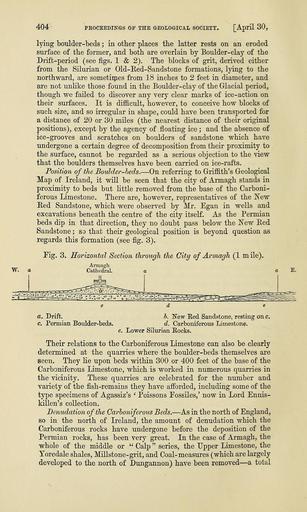MAKE A MEME
View Large Image

| View Original: | The_Quarterly_journal_of_the_Geological_Society_of_London_(13369100573).jpg (1910x3186) | |||
| Download: | Original | Medium | Small | Thumb |
| Courtesy of: | commons.wikimedia.org | More Like This | ||
| Keywords: The Quarterly journal of the Geological Society of London (13369100573).jpg 404 <br> PKOCEEDINGS 0E THE GEOLOGICAL SOCIETY April 30 <br> lying boulder-beds ; in otber places tbe latter rests on an eroded <br> surface of the former and both are overlain by Boulder-clay of the <br> Drift-period see figs 1 2 The blocks of grit derived either <br> from the Silurian or Old-Red-Sandstone formations lying to the <br> northward are sometimes from 18 inches to 2 feet in diameter and <br> are not unlike those found in the Boulder-clay of the Glacial period <br> though we failed to discover any very clear marks of ice-action on <br> their surfaces It is difficult however to conceive how blocks of <br> such size and so irregular in shape could have been transported for <br> a distance of 20 or 30 miles the nearest distance of their original <br> positions except by the agency of floating ice ; and the absence of <br> ice-grooves and scratches on boulders of sandstone which have <br> undergone a certain degree of decomposition from their proximity to <br> the surface cannot be regarded as a serious objection to the view <br> that the boulders themselves have been carried on ice-rafts <br> Position of the Boulder-beds ” On referring to Griffith's Geological <br> Map of Ireland it will be seen that the city of Armagh stands in <br> proximity to beds but little removed from the base of the Carboni- <br> ferous Limestone There are however representatives of the New <br> Red Sandstone which were observed by Mr Egan in wells and <br> excavations beneath the centre of the city itself As the Permian <br> beds dip in that direction they no doubt pass below the New Bed <br> Sandstone ; so that their geological position is beyond question as <br> regards this formation see fig 3 <br> Fig 3 Horizontal Section through the City of Armagh 1 m ile <br> a Drift <br> c Permian Boulder-beds <br> h New Eed Sandstone resting on c <br> d Carboniferous Limestone <br> e Lower Silurian Eocks <br> Their relations to the Carboniferous Limestone can also be clearly <br> determined at the quarries where the boulder-beds themselves are <br> seen They lie upon beds within 300 or 400 feet of the base of the <br> Carboniferous Limestone which is worked in numerous quarries in <br> the vicinity These quarries are celebrated for the number and <br> variety of the fish-remains they have afforded including some of the <br> type specimens of Agassiz's ' Poissons Eossiles ' now in Lord Ennis- <br> kiUen's collection <br> Denudation of the Carboniferous Beds ” As in the north of England <br> so in the north of Ireland the amount of denudation which the <br> Carboniferous rocks have undergone before the deposition of the <br> Permian rocks has been very great In the case of Armagh the <br> whole of the middle or Calp series the Upper Limestone the <br> Yoredale shales Millstone-grit and Coal-measures which are largely <br> developed to the north of Dungannon have been removed ” a total 39051336 120601 51125 Page 404 Text v 29 http //www biodiversitylibrary org/page/39051336 1873 Geological Society of London Biodiversity Heritage Library The Quarterly journal of the Geological Society of London v 29 1873 Geology Periodicals Smithsonian Libraries bhl page 39051336 dc identifier http //biodiversitylibrary org/page/39051336 smithsonian libraries Information field Flickr posted date ISOdate 2014-03-24 Check categories 2015 August 26 CC-BY-2 0 BioDivLibrary https //flickr com/photos/61021753 N02/13369100573 2015-08-26 10 55 02 cc-by-2 0 PD-old-70-1923 The Quarterly journal of the Geological Society of London 1873 Photos uploaded from Flickr by Fæ using a script | ||||